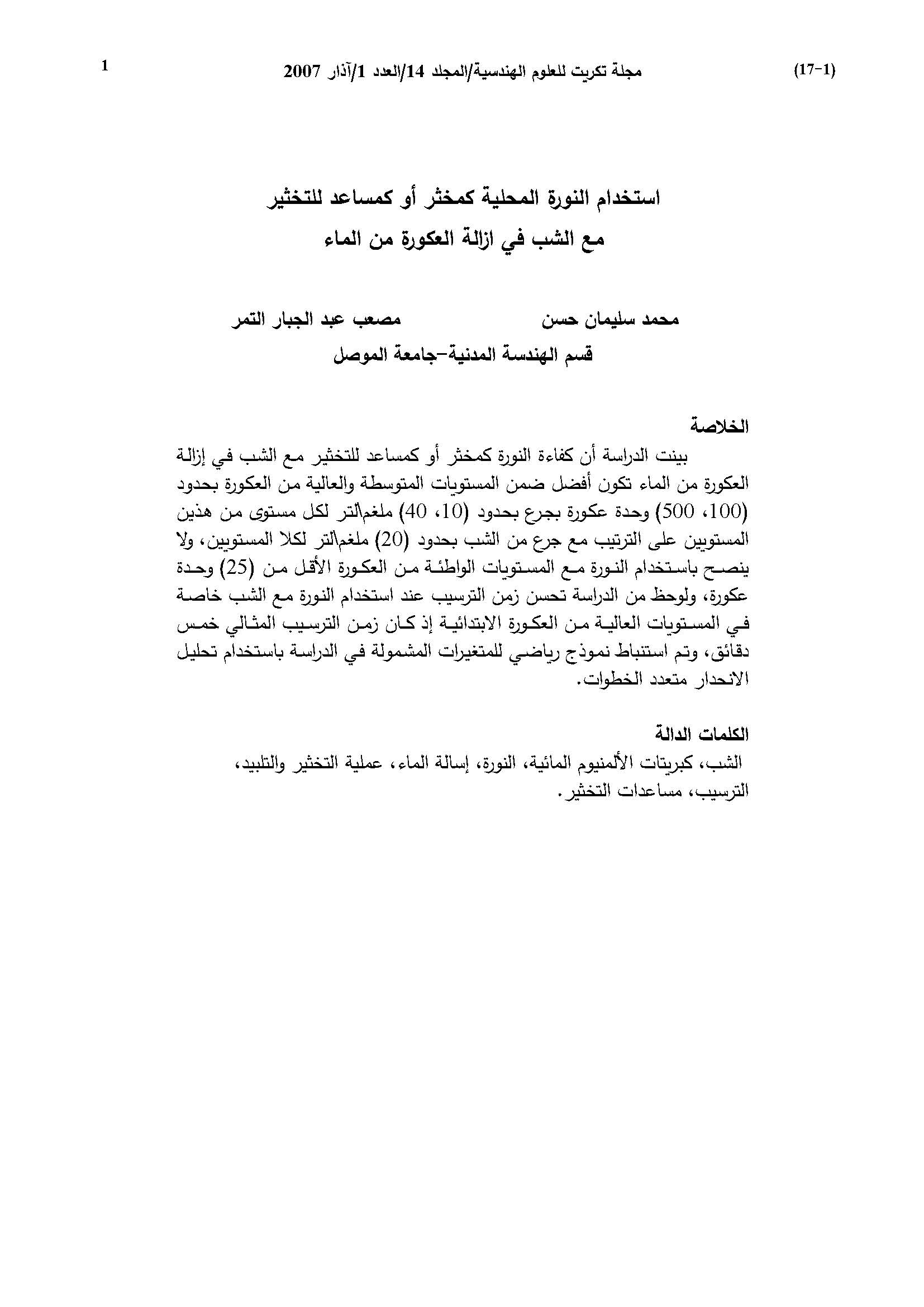The Use of Lime as A Coagulant or A Coagulant Aid With Alum in Turbidity Removal
Main Article Content
Abstract
This study revealed the efficiency of using lime as a coagulant and coagulant aid with alum in turbidity removal when it used with medium and high initial turbidity levels (100, 500) ntu with dosage of (10, 40) mg/l respectively with alum dosage of 20 mg/l, It not recommended to use lime with low turbidity limits of (25) ntu and lower. Also the used of lime with alum improved the settling time especially in high limits of turbidity. A mathematical relationship was developed variables including in the study to determine the residual turbidity by using stepwise regression analysis.
Metrics
Article Details

This work is licensed under a Creative Commons Attribution 4.0 International License.
THIS IS AN OPEN ACCESS ARTICLE UNDER THE CC BY LICENSE http://creativecommons.org/licenses/by/4.0/
Plaudit
References
Montagomery, J.M. “water Treatment, principles and design”, John Wiley Inc., New York, 1985.
Hasan, M.S., “Effect of Polyelectrolytes on Turnidity Removal of Tigris rover by Alum Coagulation”,.M.Sc. Thesis, Mosul University, 1977.
Kawamura, S.; “Chitin and Chitosan”, Penerbit University, Kebangsaan Malaysia, Bangi, 1995.
Kim, W., Ludwi, H.F. and Bishop, W.D., “Cation- exchange Capacity and pH in the Coagulation process”, Jour. Of AWWA, Vol. 57, No. 3, 1965. DOI: https://doi.org/10.1002/j.1551-8833.1965.tb01408.x
Ketchum, L.H. and Weber, W.J., “Coagulation of Storm Waters and low alkalinity wastewaters”, Jour. Of WPCF, Vol. 46, No. 1, 1974.
Jeffcoat, W.B., and Singley, J.E., “The effect of Alum concenteration”, Jour. Of AWWA, Vol. 67, No. 4, 1975. DOI: https://doi.org/10.1002/j.1551-8833.1975.tb02190.x
Yasin, A.M., “Effect of Using Lime in Conjunction with Alum and Ferric Chloride Coagulation on Turbidity and Hardness Removal”, M. Sc. Thesis, Mosul University, .1991
Randtke, S.J., Thiel, C.E., Liao, M.Y. and Yamaya, C.N., “Removing Soluble organic Contaminates by Lime- Softening”, Jou. Of AWWA, Vol. 74, No.4, 1982. DOI: https://doi.org/10.1002/j.1551-8833.1982.tb04888.x
Ham,U.K. and Christman,U.F., ” Agglomerate Size Changes in Coagulation”, Jour. Of Sanitary Engineering Division ASCE, Vol. 95, No. SA3, 1969. DOI: https://doi.org/10.1061/JSEDAI.0000967
Regunathan, P., Cleasby, J.L. and Cerwid, J.A., “Coagulation Cake Filtration”, Jour. Of AWWA, Vol. 65 No. 3, 1973. DOI: https://doi.org/10.1002/j.1551-8833.1973.tb01818.x
McCooke, N.J. and West, J.R., “The Coagulation of a Kaolinite Suspension with Aluminum Sulfate”, Vol. 12, No. 10, 1978. DOI: https://doi.org/10.1016/0043-1354(78)90029-5
Al-Layla, M.A. and Middlebrooks, B.J. “Algae removal by chemical coagulation”, Water & Sewage Works, Vol. 121, No. 9, p. 76, 1974. DOI: https://doi.org/10.1016/0043-1354(75)90035-4
Ammirtharajah, A. and Trusler, S.L. “Destabilization of particles by turbulent rapid mixing”, Jour of Environmental Engineering Division, ASCE, Vol. 112, No. 6, 1986. DOI: https://doi.org/10.1061/(ASCE)0733-9372(1986)112:6(1085)
حسن, علي عبدالله, تأثير الاملاح على إزالة المواد الغروية باستخدام هيدروكسيد المعدن, رسالة ماجستير مقدمة الى جامعة الموصل, 1994
O’Melia, C.R., Gray, K. A. and Yao, C., “Polymeric Inorganic Coagulants”, AWWA Research Foundation, Denver, 1989.
Verma, S. and Chaudhur, M.,”Colloid-Chemical Patameters for Coagulant Dose Control”, Jour. Of AWWA, Vol. 70, No. 2, 1978. DOI: https://doi.org/10.1002/j.1551-8833.1978.tb06880.x





